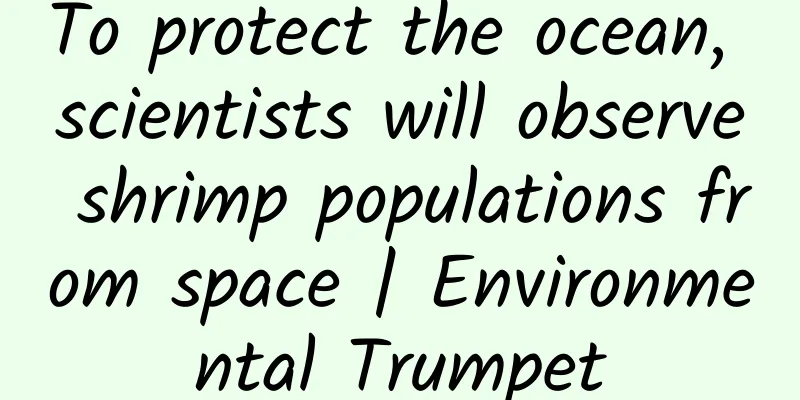To protect the ocean, scientists will observe shrimp populations from space | Environmental Trumpet

|
Hello everyone, this is the 28th issue of the Environmental Trumpet column. In this issue, we have collected the following environmental research and news worth reading: 1) Global warming is causing rat populations in cities to soar 2) There is 7 grams of plastic in the human brain, enough to make 2 disposable water cups 3) In order to find a suitable home, corals will actually "run away" 4) A “river of blood” appeared in the Argentine capital 5) To protect the ocean, scientists will monitor shrimp from space Global warming causing urban rat populations to soar A recent study published in Science Advances found that as the world warms, rat populations in cities have soared . Rat: I will have to face humans more often in the future | Pest Detective The researchers conducted a survey of 16 cities, mainly including American cities such as Washington and San Francisco, and also paid attention to two cities outside the United States, Toronto and Tokyo. The study found that in the past decade, the number of rats in 11 of the 16 cities has increased. Among them, the number of rats in Washington has increased by more than 3 times , with the largest increase; cities such as San Francisco, Toronto and New York have also observed significant increases. The increase in rats is related to the increase in the average temperature of the city. Cities with greater temperature increases have also seen greater increases in rats. Shushu, I also like big cities the most | Ecologic Entomology Researchers believe that the increase in rats is related to global warming. In the past, the activities of rats were often restricted due to cold winters. However, with warm winters in many cities, the activities of rats have increased , giving them more time to reproduce, making the rat army in cities larger and larger. Microplastics invade the human brain, with content as high as 7 grams A research team from the University of New Mexico Health Sciences and Duke University published a new paper in Nature Medicine, confirming the accumulation of microplastics in the human brain, with content as high as 7 grams. The research team used some organs of the deceased to analyze and quantitatively detect the concentration of microplastics in the human brain. Although people have previously detected the presence of microplastics in the human olfactory bulb (a neural structure in the human forebrain involved in the sense of smell), indicating that microplastics can enter the brain, this time the researchers found that there are still a lot of microplastics in the human brain, about 7 grams, which is more than the content in the liver and kidneys . What is the concept of 7 grams? It can make about 2 disposable plastic cups, which is equivalent to a medium-sized supermarket plastic bag, or half a mineral water bottle. Research has found that microplastics can even pass through the human blood-brain barrier and enter the brain | DALL·E Not only that, in the experiment, the researchers found that the concentration of microplastics in the brains of Alzheimer's patients is generally higher than that of normal people . Therefore, the researchers suspect that the content of microplastics in the brain may also be related to the probability of suffering from Alzheimer's disease. Today, more and more studies have found that people are increasingly exposed to a world full of microplastics. From 2016 to 2024, the concentration of microplastics in the human brain increased by about 50%. Considering the irreplaceable nature of plastics in people's lives and production, the concentration of microplastics in the human brain may be even higher in the future. In order to find a suitable home, corals will actually "run away" You think all corals grow quietly and quietly in the water. Corals in reality: I crawl, I crawl, I crawl everywhere! Looks cute, but actually jumps out | Emre Turak and Lyndon DeVantier A research team from the University of Queensland used time-lapse photography to record a special type of coral that is able to move around in the ocean to find a suitable home. The coral, called Cycloseris cyclolites, inflates itself to lift itself off the seafloor and use its tentacles to move forward . Ring mushroom coral: Running on long legs! | Lewis et al., PLOS One, 2025 However, the speed at which the annular mushroom coral "runs away" may not be as fast as you think. According to observations, they only moved 43.73 mm (yes, mm...) in 24 hours . Although it is slow, when they are in a less than ideal position, they can still find a better habitat by moving slowly. As global warming intensifies and ocean temperatures rise, many corals are indeed in danger of overheating their habitats . By moving, the annular mushroom coral may be able to temporarily find a more suitable habitat. Researchers reveal how these corals "walk" | Lewis et al., PLOS One, 2025 The researchers found that the annular mushroom corals do this. When exposed to white light, they tend to flee and move to where the blue light is . This means that they can sense the depth of the sea water they are in. If the sea water is shallow, the white light is strong, and the water temperature is likely to be higher, then they will move to deeper water to find a more comfortable environment to live. 'River of blood' appears in Argentina's capital Last week, the Sarandí River on the outskirts of Argentina's capital Buenos Aires turned blood red, causing panic among local residents. A river of blood | EPA The Sarandi River flows through an area where many leather processing plants and textile factories are concentrated, so local media believe that the red color of the river may be caused by nearby factories dumping textile dyes or other chemical waste. The water from the "bloody river" may also threaten the surrounding ecological reserves. | AP Photo/Rodrigo Abd What's strange is that the Sarandi River can change color. According to local media reports, the river sometimes turns yellow and emits a pungent smell. At present, researchers have collected samples of river water and will further analyze the harmful substances in the river. Some Argentine officials suspect that the pollutants in the river may be a toxic substance called " aniline ". This chemical is not only commonly used in dyes and pharmaceuticals, but also appears yellow in water. To protect the ocean, Scientists to observe shrimp swarms from space In order to observe the Antarctic Ocean, scientists have launched a big project: observing shrimps from space! This project was jointly launched by the World Wildlife Fund (WWF), the University of Strathclyde and the British Antarctic Survey (BAS) in November 2020, but was only officially announced recently. The researchers chose krill as their target of observation. Krill are only about 6 centimeters long and are important species in the Antarctic marine ecosystem. They are not only a food source for many predators, but also play an important role in the process of storing carbon in the ocean. Tiny krill are an important player in storing carbon in the ocean | HANDOUT/AUSTRALIAN ANTARCTIC DIVISION Antarctic krill can transfer about 300,000 tons of carbon to the deep sea every day . They are like "small carbon porters", eating carbon in seawater (such as carbon-rich algae), and then transporting carbon to the deep sea through feces or death, reducing the chance of carbon dioxide returning to the atmosphere, which is crucial to regulating the earth's climate. Krill are so small, how can we see them from space? In fact, scientists do not look for krill directly, but estimate the changes in the krill population by observing the color changes of the ocean . They first measure the impact of a krill on the color of the sea water, and then apply this to space observations. Schools of krill give the sea water different colors | Greenpeace Due to global warming, sea temperatures have risen, and much of the Antarctic sea ice has gradually disappeared. Krill have lost their habitat, their numbers have gradually decreased, and they have continued to migrate southward. Researchers also hope that through observations, they can more comprehensively understand the temporal and spatial distribution and changes of Antarctic krill groups and protect the stability of the Antarctic ecology. References [1]https://www.science.org/doi/10.1126/sciadv.ads6782 [2]https://www.smithsonianmag.com/smart-news/the-human-brain-may-contain-as-much-as-a-spoons-worth-of-microplastics-new-research-suggests-180985995/ [3]https://apnews.com/article/argentina-buenos-aires-river-red-industrial-leak-41a713c0ecdadadf204c330465a3f7e9# [4]https://www.sciencealert.com/this-walking-coral-moves-around-and-we-finally-know-how [5]https://www.bbc.co.uk/newsround/articles/cew5zrr2lj8o Author: Xiao Xiaoze Edited by: Yellowtail Pollock This article comes from GuokrNature (ID: GuokrNature) If you need to reprint, please contact [email protected] |
Recommend
Have you ever thought about this: the ad is great, but there is no conversion rate? What's the use! ! !
Ever since soft-text masters such as Gu Ye, Wang ...
Android Q Beta 4 experience: Let's take a look at the future of Andriod 10
Recently, Google pushed the latest beta system An...
Google Chrome for Android gets two-factor authentication
[[415122]] In order to reduce the risk of Interne...
Zhao, Qian, Sun, Li, Zhou, Wu, Zheng, Wang...How did these surnames come about?
Who am I? Where do I come from? Leaving aside the...
The underlying logical understanding of marketing planning!
Maybe we all have encountered this problem: Why d...
Jike App - Competitive Product Analysis Report
One sentence introduction: My version: A minimali...
Are the high-end internet-famous vegetables really irreplaceable?
Nutrition, health and freshness are the current t...
App Store launches a new [Video Special] recommendation entrance! Teach you how to make it and get the editor’s recommendation!
After the App Store developer website was updated,...
Breaking the Flattery Growth Camp 01
Resource introduction of Breaking the Flattery Gr...
What does the number starting with 400 mean? How do I apply for a 400 number?
Some basic processes and functions of 400 calls; ...
Full interpretation of the Central Document No. 1 of 2022: What does it specifically include? Attached is the latest interpretation of the full text
The Central Document No. 1 of 2022, "Opinion...
Can Baidu bidding still make money? Can you make money with Baidu bidding?
Of course you can. Bidding advertising accounts f...
Why is there a saying that "cold urine and hot farts"? A little physiological secret from the perspective of biomechanics
1. Introduction "Cold urine, hot farts, poor...
Can instant noodles really have a 12-month shelf life? How can we prevent free radicals like viruses?
Recently, the media interviewed the following que...
How much does it cost to develop a Shuangyashan flower mini program?
Shuangyashan flower mini program investment promo...









